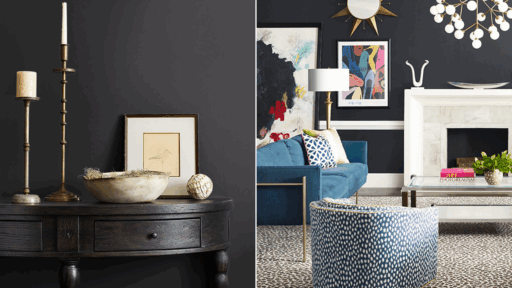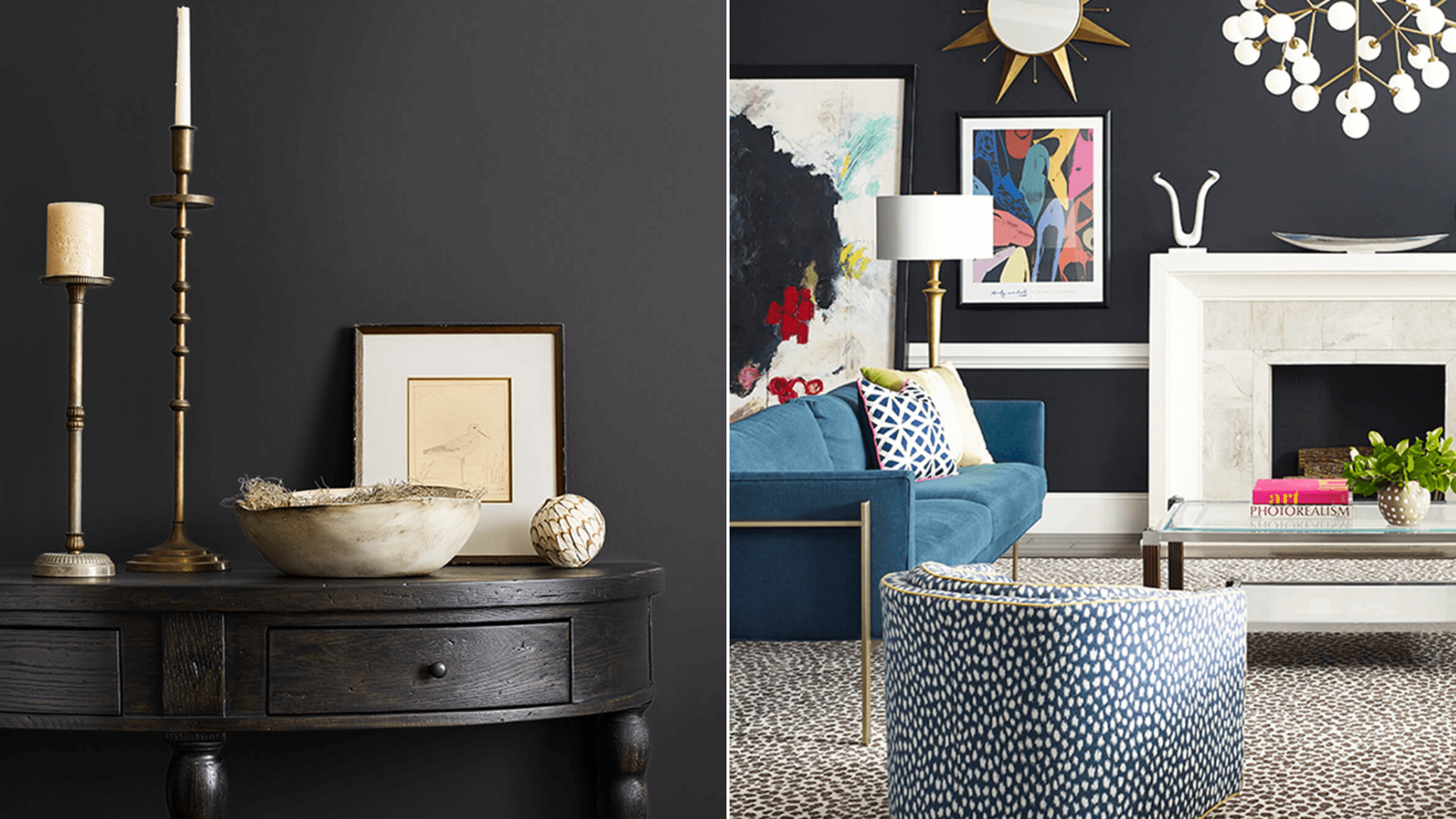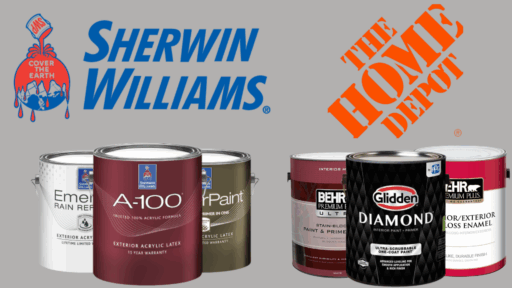When choosing the perfect black paint for your home, two options often stand out: Sherwin-Williams Caviar and Tricorn Black.
Both are rich, dark shades, but they have subtle differences that can make a big impact on your space.
I’ve seen both colors used in various settings, and each one brings something unique to the table.
Caviar has a slight warmth to it, while Tricorn Black is a more neutral, pure black.
In this blog, I’ll walk you through the main differences between these two shades, share where they work best, and help you decide which one might be right for your next project.
If you’re updating your living room or painting an accent wall, understanding these two colors will make it easier to choose the one that fits your style.
Understanding Sherwin-Williams Caviar and Tricorn Black
Sherwin-Williams Caviar is a rich, deep black with a hint of warmth. It’s not just a flat black; it has a slight touch of brown or charcoal undertones.
This makes it feel cozy and inviting, rather than too harsh. Caviar works particularly well in rooms that require a touch of elegance, such as dining rooms or bedrooms.
It’s also great if you’re looking to add depth and make your space feel warm and sophisticated.
Sherwin-Williams Tricorn Black, on the other hand, is a true black. It doesn’t have any undertones, making it a pure, neutral black. It’s clean and crisp, perfect for modern or minimalist spaces.
Tricorn Black can create a bold statement, especially in areas like accent walls, cabinets, or even exteriors.
Since it’s neutral, it pairs well with a wide range of colors and works in both bright and dimly lit rooms.
Both colors are beautiful, but choosing between them comes down to the feel you want for your room.
Key Differences Between Sherwin-Williams Caviar and Tricorn Black
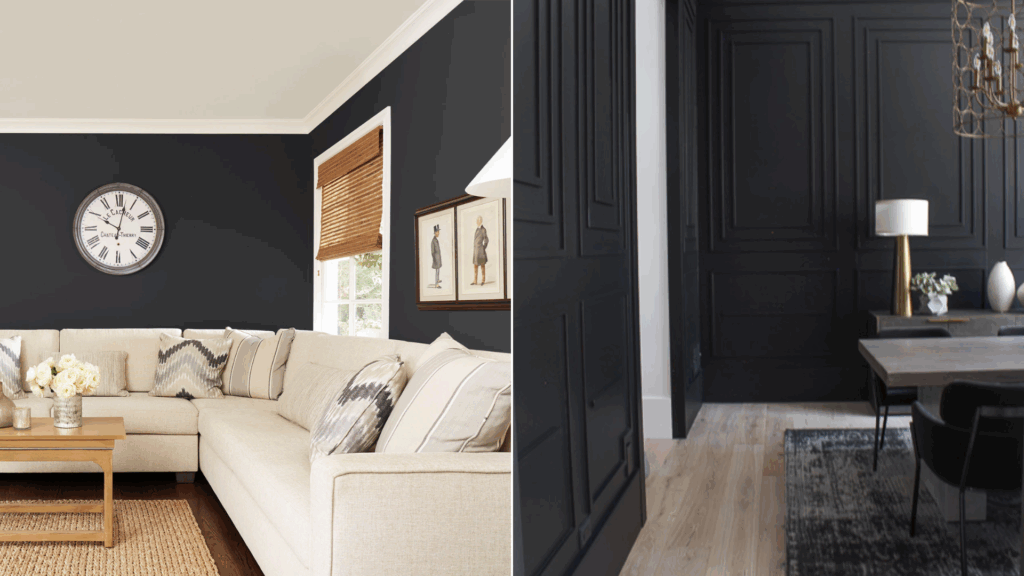
Sherwin-Williams Caviar (SW 6990) and Tricorn Black (SW 6258) are both popular black paint colors, but they have distinct characteristics that make them stand out in different ways.
1. Undertones: Warm vs. Neutral
Caviar is a black with warm undertones, which means it has a touch of brown or charcoal in it. These undertones give the color depth and warmth, making it feel more inviting and cozy.
Caviar isn’t a harsh, in-your-face black; instead, it creates a softer, more comfortable atmosphere.
It’s perfect for spaces where you want to add a bit of character but still keep things relaxed.
Tricorn Black, on the other hand, is a pure black with no noticeable undertones. It’s what you might call a “true” black.
There’s no hint of warmth, coolness, or any color in between.
This gives Tricorn Black a sharp, clean appearance. It’s the kind of black you see in high-contrast, modern designs, making it feel sleek and bold.
2. Light Reflectance Value (LRV): Same Dark Intensity
Both Caviar and Tricorn Black have the same Light Reflectance Value (LRV) of 3. This means they are both extremely dark shades of black and will absorb most of the light in a room.
In other words, they will make any space feel a bit smaller and more intimate, which can be a good or bad thing depending on the room’s size and the overall vibe you’re trying to create.
Even though both colors have the same LRV, the experience of how dark they feel can differ due to the undertones.
3. Style Compatibility: Traditional vs. Modern
Because of its warmth, Caviar is a great choice for more traditional or transitional spaces. It pairs well with warm wood tones, rich textiles, and classic design elements.
If you’re going for a design style that includes antiques or vintage-inspired elements, Caviar complements those pieces wonderfully.
Tricorn Black fits perfectly in modern, contemporary, or minimalist spaces. It’s a versatile color that can help create high-contrast looks, especially when paired with whites or bright colors.
It’s great for sleek, urban environments or spaces that feature clean lines and simple, modern furniture.
4. Mood and Atmosphere: Cozy vs. Bold
With its warm undertones, Caviar tends to create a more cozy and welcoming atmosphere.
It’s great for rooms where you want to relax and unwind, like living rooms, bedrooms, or even home offices.
Tricorn Black, being a neutral and pure black, creates a bold and dramatic mood. It can add a sense of sophistication to a space, but it can also feel a little more intense or serious.
If you want to create a room that makes a statement or feels sleek and modern, Tricorn Black is the go-to choice.
- Choose Caviar if: You want a warm, inviting black that feels cozy and elegant, especially in traditional or transitional spaces. It’s great for rooms where you want to relax and feel at home.
- Choose Tricorn Black if: You want a sharp, sleek, and modern black that creates a dramatic contrast in your space. It’s ideal for contemporary or minimalist designs and makes a strong visual statement.
No matter which color you choose, both Caviar and Tricorn Black will elevate your space, so it’s really about what kind of vibe you’re after.
Pros and Cons of Sherwin-Williams Caviar vs Tricorn Black
Both Sherwin-Williams Caviar and Tricorn Black are stunning options, but each has its own strengths and weaknesses.
Caviar
| Pros | Cons |
|---|---|
| Warm Undertones – Adds a cozy, inviting feel to a room. | Can Feel Heavier – In some spaces, the warmth might make the room feel smaller or darker. |
| Elegant and Sophisticated – Works well in traditional or formal spaces. | Not Pure Black – If you want a true, neutral black, Caviar might not be the right choice. |
| Great for Accent Walls – Perfect for creating a focal point in a room. | Lighting Effects – The warm undertones may look different under various lighting conditions. |
| Versatile in Decor – Pairs well with a variety of other colors, especially rich or earthy tones. | Needs Careful Pairing – Can clash with cooler-toned decor. |
Tricorn Black
| Pros | Cons |
|---|---|
| True Black – A pure, neutral black without any undertones. | Can Be Harsh – Might be too bold or intense for some rooms, especially in smaller spaces. |
| Timeless and Sleek – Works well with modern or minimalist designs. | Can Make Rooms Feel Smaller – The depth of the color might make a room feel closed off if not balanced properly. |
| Highly Versatile – Pairs well with almost any other color. | Difficult to Match with Warm Tones – May not work well with warmer or earthy decor styles. |
| Ideal for Contemporary Spaces – Perfect for modern, clean looks. | Too Flat for Some Spaces – Lacks the warmth and depth that some may prefer in a black. |
If you want a rich, warm black that adds sophistication and coziness, Caviar might be your go-to.
However, if you’re seeking a clean, sleek black that complements almost any decor, Tricorn Black may be your perfect match.
Either way, testing samples in your room is always a good idea to see how the color interacts with your space’s lighting and furnishings!
Applications: Where to Use Caviar vs Tricorn Black
Both Caviar and Tricorn Black can be used in a variety of ways, but the way they impact a space can be quite different due to their undertones and general appearance.
Sherwin-Williams Caviar (SW 6990)

- Best for: Traditional living rooms, bedrooms, accent walls, libraries, and cozy dining areas.
- Why: Caviar’s warm undertones make it perfect for creating a cozy, inviting atmosphere. It works well with rich wood tones, soft fabrics, and traditional décor.
- Uses: You can use Caviar on walls, furniture, or as an accent to highlight a space without feeling too overwhelming. It’s also a great choice for exterior applications, such as front doors, to give your home a classic look.
Sherwin-Williams Tricorn Black (SW 6258)
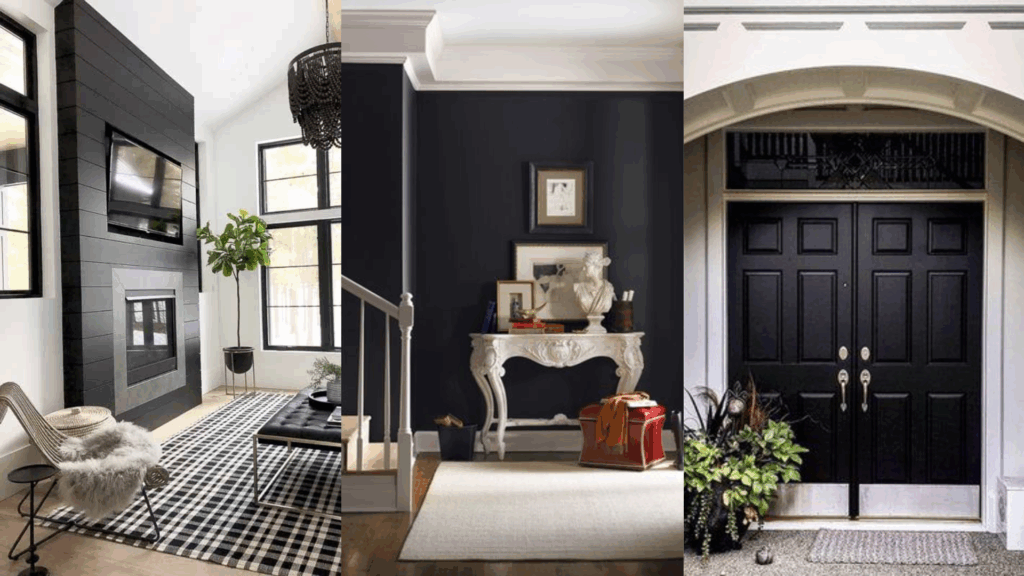
- Best for: Modern or contemporary spaces, accent walls, kitchen cabinetry, exterior doors, and industrial design.
- Why: Tricorn Black has a bold, neutral appeal that can fit into any modern space, whether it’s used as an accent or as the main color in a room.
- Uses: Tricorn Black works wonders as a statement color. It’s excellent for high-contrast looks, especially when paired with whites, grays, or light wood tones. It also works well in both interiors and exteriors.
Conclusion
Choosing between Sherwin-Williams Caviar and Tricorn Black ultimately depends on the feel you’re going for in your space.
If you want a warm, inviting black that adds a cozy, sophisticated touch, I’d recommend Caviar.
Its subtle undertones make it a perfect choice for rooms where you want to create a more intimate and classy atmosphere.
On the other hand, if you’re after a sleek, modern look with a true, neutral black, Tricorn Black is the way to go.
It pairs well with nearly any color and works especially well in contemporary or minimalist spaces.
I always suggest testing both colors in your room before committing, as lighting can significantly alter their appearance.
Ultimately, both are stunning options, but I hope this comparison helps you decide which one best suits your style and needs!

